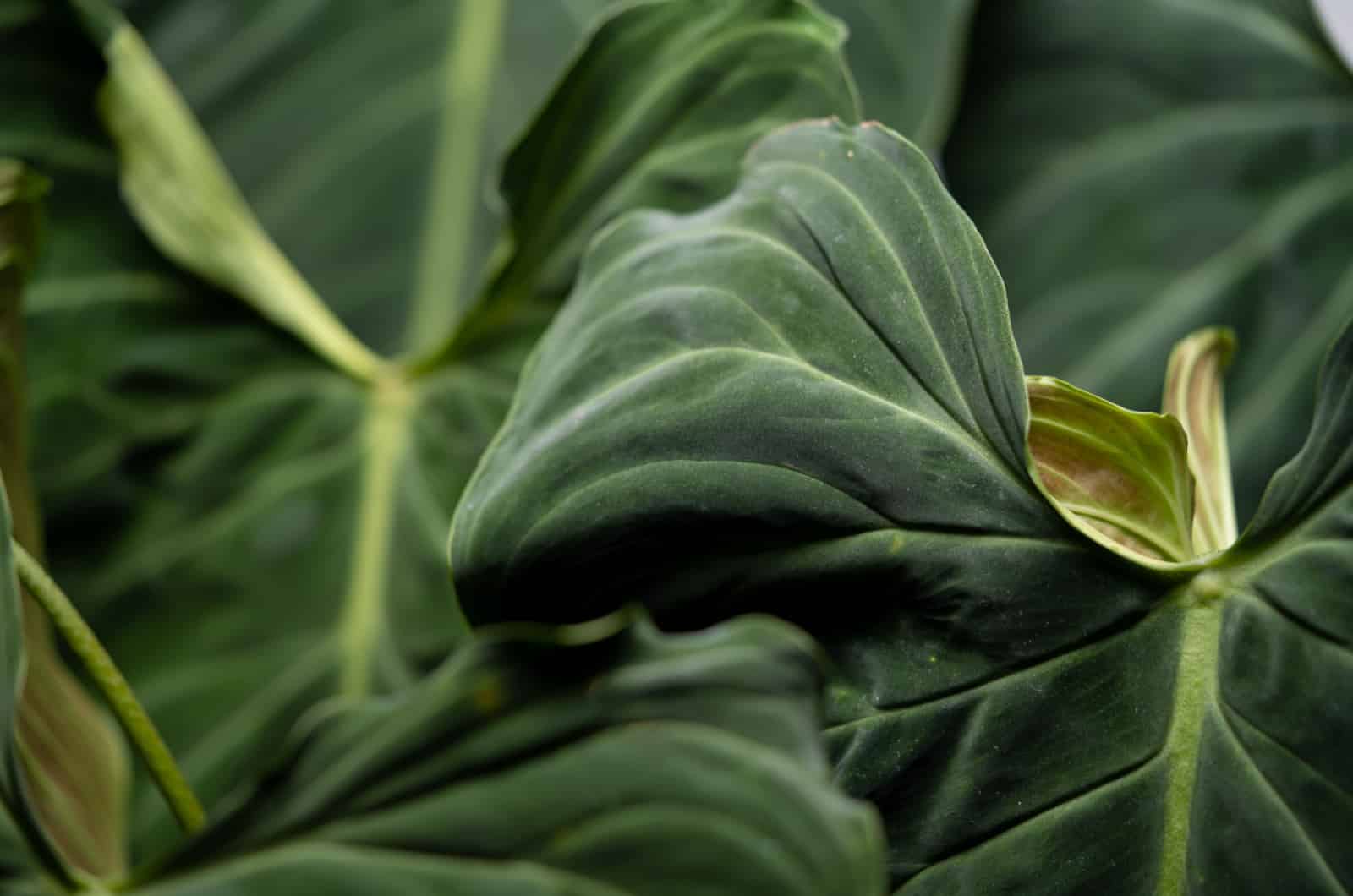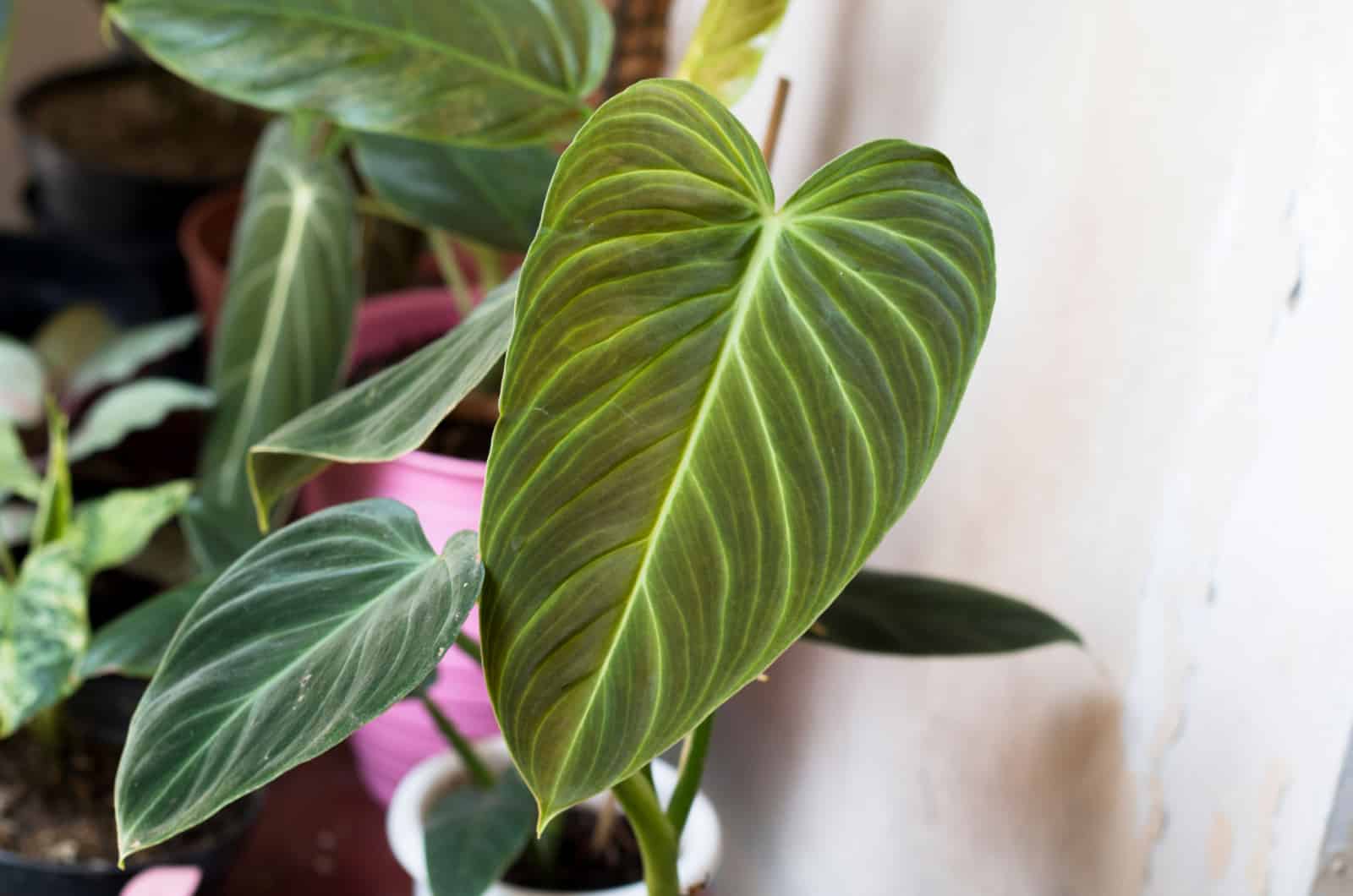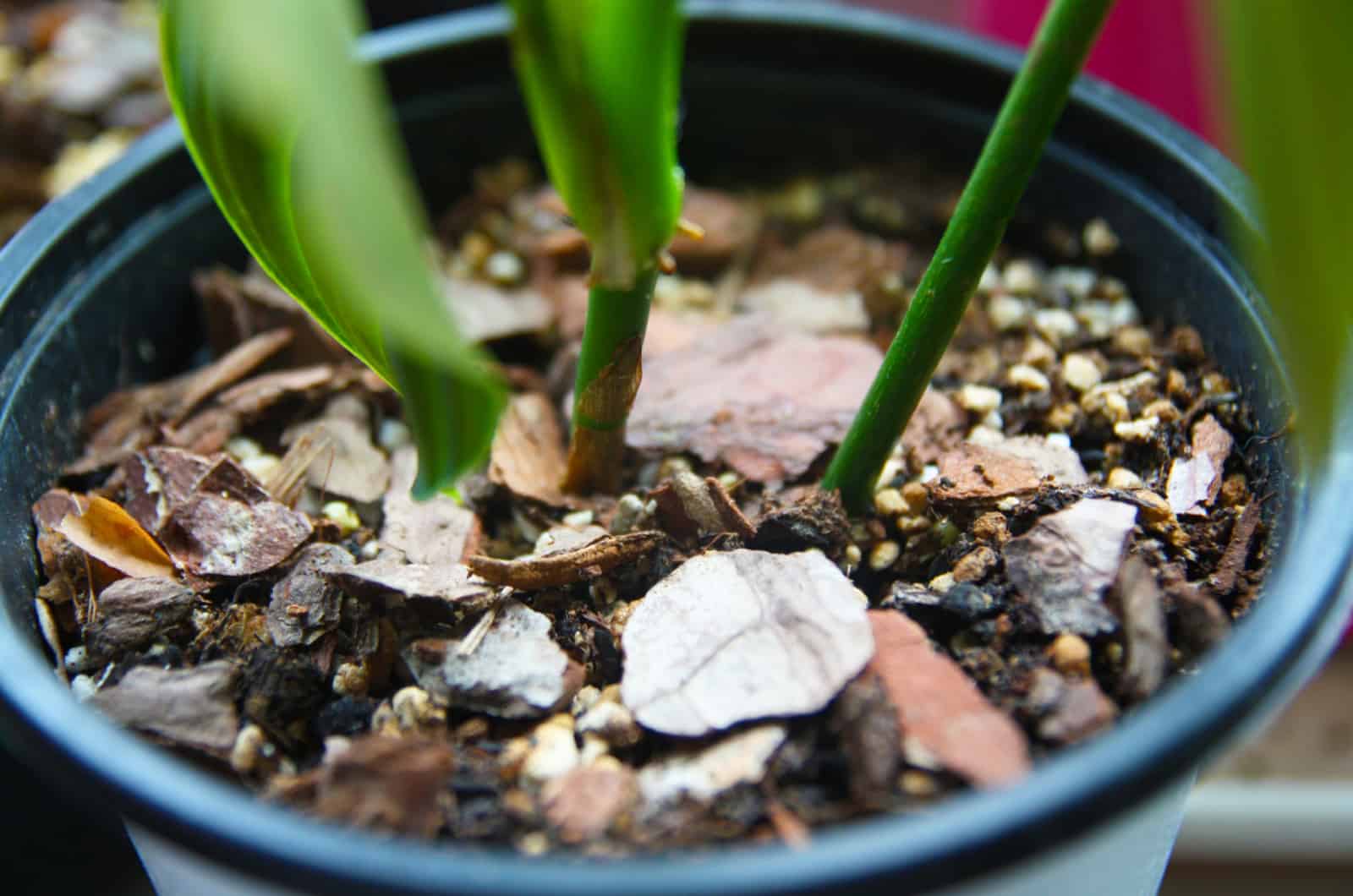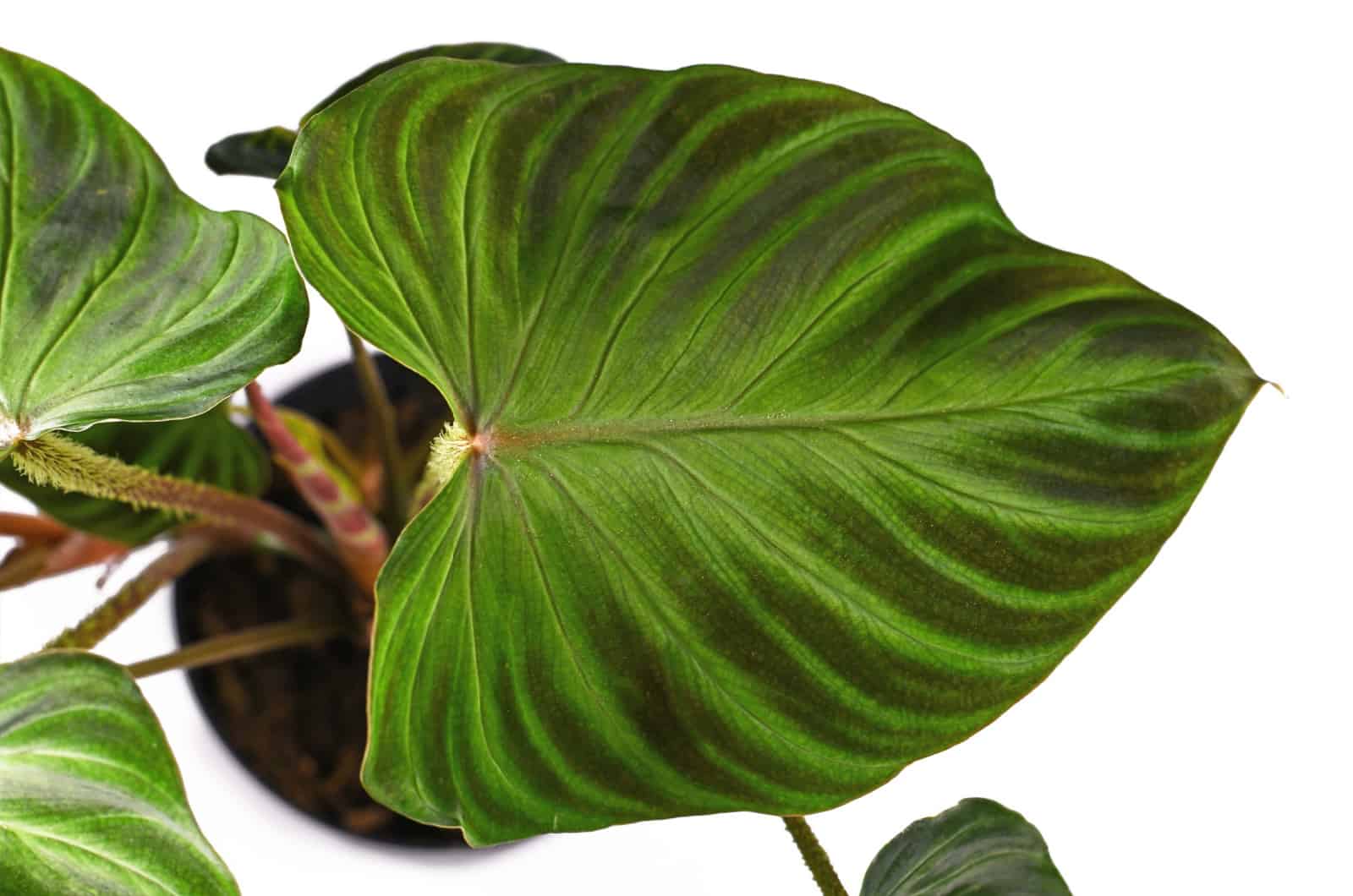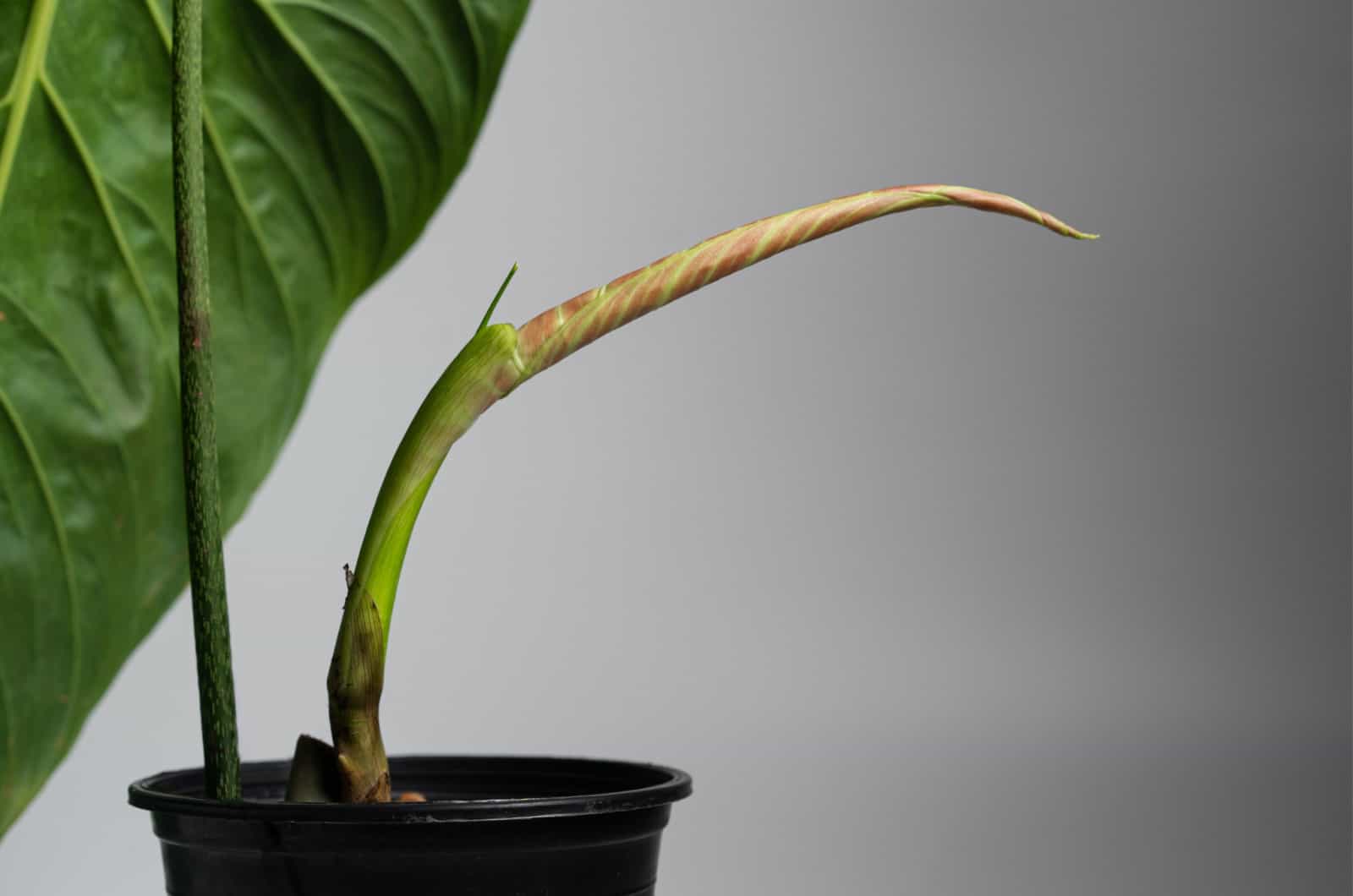Oh, those beautiful Philodendrons! So many unique and breathtaking species adorn plant collections all over the world.
Everyone has heard of Philodendrons, including those who have never grown a plant in their life.
Philodendron verrucosum is a fascinating plant, along with Philodendron melanochrysum.
Today I’ll tell you more about the hybrid of the two species – Philodendron verrucosum x melanochrysum, commonly known as splendid Philodendron.
A special thing about this Philodendron species is that it has the characteristics of both verrucosum and melanochrysum, but is still unique and fascinating.
We’re going to learn more about the looks of this Philodendron, as well as how to tell it apart from the parent plants and other similar Philodendrons.
You’ll also find a complete care guide and tips on propagating the splendid Philodendron.
Finally, I’ll show you some issues your Philodendron may face and how to deal with them.
Let’s first find out some basic info about this plant:
[table id=316 /]Let’s get started!
What Does The Splendid Philodendron Look Like?
All species from the Philodendron genus have common characteristics that stand out in the plant world.
The majority of species have massive leaves with unique veinings. Most species differ in shape and size of the leaves and the mature size of the plant.
Let’s find out more about the parents of the splendid Philodendron, and how to differentiate between them.
Splendid Philodendron vs Verrucosum
All Philodendron verrucosum types share certain features, such as massive, heart-shaped leaves. The parent plant features velvety leaves that usually come in an emerald green color and have highlighted, light green veinings.
However, juvenile leaves won’t be emerald green at first; they emerge as dark green and gradually change color.
One of the most fascinating features of the verrucosum plant is the burgundy undersides of the leaves.
The leaves can reach about 2.5 feet long in their mature stage.
So, how can you differentiate between a splendid Philodendron and Philodendron verrucosum?
The Splendid has longer leaves that are usually darker in color. Additionally, it features less noticeable and paler veins.
As far as size is concerned, it mainly depends on the variety and the conditions you provide the plant.
Splendid Philodendron vs Melanochrysum
Hailing from the rainforests of beautiful Colombia, Philodendron melanochrysum will leave everyone breathless with its very dark green leaves. The juvenile leaves are usually reddish-orange to orange-brown in color.
The Melanochrysum is often referred to as black gold Philodendron because if you take this plant out and let the sun rays reach the leaves, you’ll notice tiny golden spots on the almost black leaves. How remarkable!
The leaves of the melanochrysum are longer and darker than those of a splendid Philodendron. The Splendid has wider leaves and won’t display golden spots when exposed to sun rays.
The veinings of the splendid Philodendron are also more noticeable.
The Splendid Philodendron isn’t the only hybrid whose parent plant is melanochrysum – the Philodendron glorious is a hybrid of melanochrysum and gloriosum.
Other Similar Species
Now you know how to differentiate a Philodendron splendid from its parent plants, but the story is far from over! Other Philodendron species share similar features with the splendid, which is why they’re often confused.
The Philodendron gloriosum is a rare Philodendron species, and its dark, heart-shaped leaves often trick growers into thinking it’s a splendid Philodendron.
However, the leaves aren’t as dark as the splendid Philodendron, and are usually shorter. The veinings of the Philodendron gloriosum are also more noticeable.
Another Philodendron species with heart-shaped leaves and burgundy undersides is the Philodendron micans.
This vining Philodendron has smaller leaves and much darker veinings than those of a splendid Philodendron.
Philodendron Splendid Care Guide
The Splendid Philodendron is thought of as a low-maintenance plant, and it’s pretty easy to keep it happy and healthy.
Here’s a table with an overview of the splendid Philodendron plant care guide:
[table id=317 /]Let’s get into details!
How Much Light Does A Splendid Philodendron Need?
The best way to take care of the Philodendron plant is by recreating conditions in its natural habitat as closely as possible. This is a tropical plant, but contrary to popular opinion, it doesn’t like direct sunlight.
It needs partial shade instead of direct sunlight, however, low light may also cause trouble.
Where to place your plant, then? You first need to find a spot near a sunny window so your splendid Philodendron receives enough bright light.
A north-facing window isn’t an option as the light level there isn’t enough for this Philodendron. If you can’t find any other place, you can use grow lights, which are readily available on Amazon.
A south-facing window receives a lot of bright light, and intense sunlight can easily reach the leaves there. I recommend placing sheer curtains over the window to protect the leaves from the strong midday sun.
A west or east-facing window should fulfill the light requirements of your splendid Philodendron. The morning sun will reach the plant, but won’t burn it, and the intense sun won’t reach it during the day.
If your splendid Philodendron is leggy and displays stunted growth, check if it’s receiving enough light.
On the other hand, if the leaves are scorched and the plant is wilting, it’s most likely receiving too much light. Only variegated Philodendron species require more light.
Humidity Requirements
The Splendid Philodendron doesn’t like too much light, but it adores high humidity! Anything less than 50% will harm your precious Philodendron, and you will not like what you see.
I recommend keeping the humidity level above 60%.
As this humidity level isn’t typical for homes, you’ll need to boost it artificially. I have a few methods to help you get the perfect humidity level for your splendid Philodendron.
Before trying the method below, I suggest getting a hygrometer to measure humidity accurately.
Method 1: Microclimate
Creating a microclimate may seem complicated, but it’s actually the easiest way to raise humidity.
If you grow other houseplants, like Monsteras, you’ll be happy to hear that placing your splendid Philodendron next to other plants will benefit them both.
The water will evaporate from the soil and raise the humidity level.
I love this method as my plants look even more beautiful when they are hanging out together.
Method 2: Pebble Tray
The question is, do pebble trays increase humidity? If the humidity level in your household is too low, the pebble tray method alone won’t be enough.
But it’s possible to raise humidity further by combining it with other methods.
Pebble trays look great underneath pots, and are affordable. The fact that there are DIY versions makes this method even more attractive.
Get a shallow container, put pebbles in it, pour some water in, and place your splendid Philodendron on it.
The roots of this Philodendron are very sensitive and can be severely damaged if they come into contact with water.
When using the pebble tray method, please make sure that the roots aren’t ever sitting in water.
Method 3: Two Pots
For the two-pot method, you’ll obviously need two pots. Still, the original pot for your Philodendron splendid should be smaller than the other one.
If you have a mature splendid Philodendron, it may be pretty hard to lift it, so consider using another method if lifting a 5 foot plant isn’t your cup of tea.
If your splendid Philodendron is in its early growth stages, place it in a larger pot with sphagnum moss in the bottom. Wet the sphagnum moss so that the water evaporates and your splendid Philodendron gets more humidity.
Method 4: Humid Room
When buying houseplants, people like to place them in living rooms or bedrooms.
However, indoor plants can also be placed in bathrooms or kitchens. They’ll make great additions to these rooms, and they’ll also benefit from the high water evaporation in bathrooms and kitchens . Your splendid Philodendron will receive plenty of humidity if placed in these areas.
Method 5: Humidifier
The last method doesn’t include lifting or DIY skills. The safest way to raise humidity, especially for beginners, is by using a humidifier.
Of course, a humidifier is more expensive than pots or pebbles, but the fact you won’t have to worry about humidity any longer makes it worth it!
The Ideal Temperature
Tropical plants thrive in warmer temperatures, and the splendid Philodendron is no exception.
The perfect temperature range for a splendid Philodendron is from 65 to 85 degrees Fahrenheit.
This Philodendron won’t be damaged by slightly lower or higher temperatures, but problems will arise if they drop below 50 degrees Fahrenheit.
There are certain places to avoid putting a splendid Philodendron. First, make sure your Philodendron isn’t near any fireplaces, heating vents, or radiators.
Temperature fluctuations can quickly harm your splendid Philodendron, so pay attention to this when choosing the right spot.
You should also avoid spots near cooling vents and air conditioners because cold drafts are extremely dangerous to a splendid Philodendron.
Best Potting Mix
Your splendid Philodendron requires well-draining soil and hates overly saturated soil, so you should pay close attention to the materials used in the potting mix.
You can use an aroid soil blend or similar loamy and fertile soil types to enhance drainage and ensure good aeration. This is also the best way to avoid water pooling.
The Splendid Philodendron grows in fertile soil that contains decaying materials in its natural habitat. As a result, regular garden soil is not an alternative because it has insufficient aeration for indoor plants.
There are a couple of materials you can use to provide good aeration and drainage, such as perlite, pumice, orchid bark, compost based on loam, and similar materials.
I combine peat moss, perlite or pumice, and orchid bark, and cover the blend with worm castings.
The Splendid Philodendron thrives in slightly acidic potting soil, and I always add compost to slightly raise the pH levels.
How And When To Water A Splendid Philodendron
There are several factors that affect the watering schedule of a splendid Philodendron.
First, this Philodendron starts its growing season in the early spring, so its watering needs will increase due to active growth. Once the winter approaches, you should wait longer between waterings.
Other factors to consider include temperature, humidity, light level, and soil type. Warmer temperatures will promote water evaporation from the splendid Philodendron soil, so you’ll need to water it more often.
Low humidity reduces water evaporation, which means that you’ll need to cut back on watering.
A rule of thumb is to water your splendid Philodendron once the top 2-3 inches of soil are dry.
The Splendid Philodendron, just like other plants from the aroid family, is extremely sensitive to overwatering. In fact, the easiest way to kill a Philodendron is by overwatering it.
Later in the article, you’ll find out more about the consequences of overwatering.
Another watering issue is underwatering. Remember, the soil should never be soggy or completely dried out. Unfortunately, the splendid Philodendron isn’t drought-tolerant.
How To Avoid Watering Issues
Here are a couple of tips for you to avoid watering issues:
1. Always check moisture levels in the splendid Philodendron soil. You can use your finger, a wooden stick, or a moisture meter to check soil moisture.
2. Don’t use all the water you prepared at once: pour gradually to allow the soil to absorb enough water.
3. Pots with drainage holes are your best friends now. Stop watering as soon as the water starts coming out of them.
4. Make sure the Philodendron splendid pot isn’t too large or too small; your goal is to avoid both water pooling and the plant becoming root bound.
Fertilizing Schedule
The Splendid Philodendron only displays growth during the growing season, which is why it needs food during this period.
However, feeding it too often can result in fertilizer burn, so I recommend only applying fertilizer monthly.
When it comes to the fertilizer type, you’ll need a balanced fertilizer such as triple 20. Don’t forget to dilute it to half strength as it may be too harsh for your splendid Philodendron.
Potting & Repotting
The Splendid Philodendron doesn’t like being rootbound, so you’ll need to repot it every other year. Stunted growth and roots coming out of the drainage holes are indicators of a rootbound plant.
Before you start repotting, prepare the following:
1. A new pot: it should be slightly bigger than the one your splendid Philodendron is currently in. Around 2 inches larger in diameter will suffice.
2. Fresh soil: your splendid Philodendron will certainly benefit from new nutrients, and you’ll also help prevent contamination.
3. Cutting tools: always check the health condition of the roots, and if some are damaged you can remove them using sanitized tools.
Take your splendid Philodendron out of the pot and place it in a new soil mix. Once the transplant is complete, water the soil thoroughly.
Staking
The Splendid Philodendron is a climber, so it will need support.
I recommend staking your Philodendron with a moss pole or something similar.
You’ll also need something to secure the plant to the support structure; I always use twist ties.
Cleaning
The Splendid Philodendron has large leaves that must be cleaned from time to time.
They look less breathtaking when dust collects on them, and may also trick you into thinking that your Philodendron has white spots or paleć leaves, so clean them regularly.
Philodendron Verrucosum x Melanochrysum: Propagation
There is an excellent way to get even more of these rare plants! Luckily, the splendid Philodendron is easy to propagate, which is another reason this plant is so great for beginner gardeners.
The best way to propagate the splendid Philodendron is through stem cuttings. You can root the cuttings in water or plant them directly in the soil.
Let’s learn about both ways!
Stem Cuttings In Water
For water propagation, you’ll need to prepare a healthy splendid Philodendron, a sharp and sanitized pair of shears (use bleach or rubbing alcohol), and a jar or clear vase.
Here are the steps for water propagation:
1. Select a cutting on your splendid Philodendron that has a node attached. Make an incision with sanitized shears.
2. Fill a jar/vase with lukewarm, filtered water, and submerge the cutting in it. Pay attention to nodes because at least one should be immersed in water.
3. Place the rooting medium with the splendid Philodendron cutting in bright indirect light.
4. Change water in the jar every 2 to 3 days to prevent the splendid Philodendron cutting from rotting.
5. New growth typically appears in a few weeks. Once you spot new roots, transplant them into adequate potting soil.
Stem Cuttings In Soil
If you decide to root the splendid Philodendron stem cuttings in soil, prepare a new potting mix, a sharp pair of pruners, and a rooting hormone.
Here are the steps for soil propagation of the splendid Philodendron:
1. Take the cuttings the same way as for water propagation.
2. Fill the container with a potting mix. I recommend mixing peat moss, perlite, orchid bark, and worm castings.
3. Poke a hole in the center of the soil large enough to fit the splendid Philodendron cutting.
4. Put the cutting in the hole and add soil if necessary.
5. Place the container in bright indirect light and warm temperatures.
6. The roots will appear after a couple of weeks, so make sure all conditions are appropriate.
You can also check out our guide to propagating the Philodendron birkin.
Common Issues
Your splendid Philodendron can be affected by certain pests and diseases, and will display changes as a result of inappropriate conditions.
Let’s find out more!
Pests
Pest infestations aren’t uncommon, and you will most likely deal with one if you grow many houseplants. Pests aren’t dangerous in small numbers, but if they form a colony, you’re in trouble.
If you spot any pest species in time, you can easily remove them and prevent them from damaging your splendid Philodendron.
If the infestation becomes severe, removing all the pests will take a lot of time.
You can expect to find spider mites, mealybugs, and aphids on the large leaves of your splendid Philodendron.
Here are some characteristics of each pest and how to recognize them.
Spider mites: Soft-bodied insects that leave silky webbing on the leaves. Watch out for spider eggs in the soil of the plant.
Mealybugs: These pests are covered with a cotton-like substance, spread pretty fast, and thrive in humid environments.
Aphids: You can typically find aphids on the undersides of leaves. They usually gather in large groups, mainly affect new growth, and drink plant juices, which weakens the plant.
How To Remove Pests
Here is a list of the best cures for pest infestation:
1. Insecticidal soap: Mix the soap with water and spray the entire splendid Philodendron.
2. Neem oil: This oil can help you control pests during flowering. Follow the instructions and your splendid Philodendron will be pest-free in no time.
3. Rubbing alcohol: Another common method for pest removal. Rub it on the leaves or dilute it with water and spray it over the splendid Philodendron.
Diseases
Although the splendid Philodendron isn’t prone to many diseases, it’s not completely disease-free.
The most common is root rot. Leaf spot rarely occurs unless some other plant is affected.
Your splendid Philodendron will most likely get root rot if it’s overwatered.
Check the root system if you notice any of the symptoms of root rot, such as yellowing, browning, mushy soil, or a bad smell.
Remove the rotting roots of your splendid Philodendron with sanitized tools. Apply fungicide, and repot the plant using the tips above.
Leaves Turning Yellow
Here is a list of the possible causes of yellow leaves:
1. Overwatering: Yellow leaves mainly develop if the soil is overly saturated, and typically signify root rot.
2. Direct sunlight or low light: Always check the light levels if the large leaves start turning yellow.
3. Underwatering: If your splendid Philodendron is dehydrated it will display yellowing.
4. Low humidity: If there’s not enough humidity, the soil retains too much water, attracts fungus, develops root rot, and the leaves turn yellow.
Brown Leaves
Here is a list of possible causes of brown leaves:
1. Watering issues: When your splendid Philodendron lacks water, its velvety leaves may turn brown. If you notice brown spots, you may have overwatered your plant.
2. Temperature stress: If the temperatures are above 90 degrees Fahrenheit, your splendid Philo may go through temperature stress and display browning.
3. Fertilizer burns: If you feed your splendid Philodendron with too much or an inadequate fertilizer, the leaves will get burned.
Curling, Wilting, And Drooping
If your Philodendron splendid lacks water, it will display many symptoms.
First, you’ll notice that the leaves have started to curl to try and save water by reducing their surface.
If your Philo is severely dehydrated, it may start drooping and wilting, and eventually die off.
FAQs
Is The Philodendron Splendid Toxic?
Yes, the splendid Philodendron is toxic to humans and pets, just like all plants from this genus.
They contain insoluble calcium oxalates, and if you, your children, or your pets ingest the leaves, the crystals will activate.
Oral irritation, swelling, and a burning sensation are all consequences of this toxin.
What Is A Philodendron El Choco Red?
The Philodendron el choco red is another species from the Philodendron genus. It’s a desired plant of many growers as it has red, velvety leaves when juvenile.
This fast-growing climber may reach 3 feet tall if all requirements are met. It’s very similar to Philodendron verrucosum, and requires similar conditions.
What Is The Price Of A Philodendron Splendid?
The regular price of a splendid Philodendron ranges from $40 to $100, depending on the site or store you are purchasing it from.
It may be challenging to find this plant, so don’t miss the chance when you come upon one.
Wrapping Up
If you are looking for a beautiful and low-maintenance plant, the splendid Philodendron species is perfect for you!
It’s one of the most fascinating plants from the Philodendron genus, and one of the most interesting members of the entire Araceae family.
This unique hybrid will make any place prettier, but pay attention to where you put it because it’s toxic, so keep it away from toddlers and pets.
Until next time!
Like this post? Share or pin it for later!

